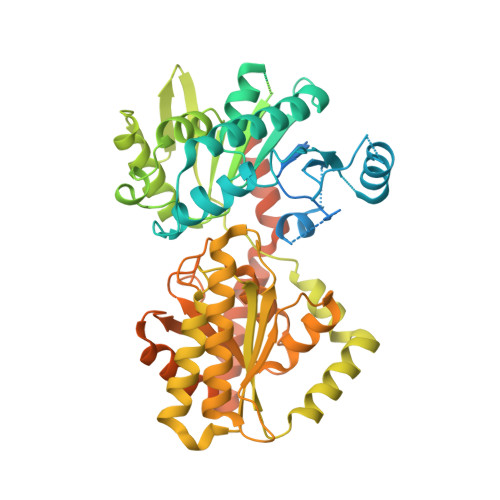Structures of trehalose-6-phosphate synthase, Tps1, from the fungal pathogen Cryptococcus neoformans : a target for novel antifungals.
Washington, E.J., Zhou, Y., Hsu, A.L., Petrovich, M., Borgnia, M.J., Bartesaghi, A., Brennan, R.G.(2023) Biorxiv
- PubMed: 36993618
- DOI: https://doi.org/10.1101/2023.03.14.530545
- Primary Citation of Related Structures:
8FHW - PubMed Abstract:
Invasive fungal diseases are a major threat to human health, resulting in more than 1.5 million deaths worldwide each year. Yet the arsenal of antifungal therapeutics remains limited and is in dire need of novel drugs that target additional fungal-specific biosynthetic pathways. One such pathway involves the biosynthesis of trehalose. Trehalose is a non-reducing disaccharide composed of two molecules of glucose that is required for pathogenic fungi, including Candida albicans and Cryptococcus neoformans , to survive in their human hosts. Trehalose biosynthesis is a two-step process in fungal pathogens. Trehalose-6-phosphate synthase (Tps1) converts UDP-glucose and glucose-6-phosphate to trehalose-6-phosphate (T6P). Subsequently, trehalose-6-phosphate phosphatase (Tps2) converts T6P to trehalose. The trehalose biosynthesis pathway has been identified as a top candidate for novel antifungal development based on quality, occurrence, specificity, and assay development. However, there are currently no known antifungal agents that target this pathway. As initial steps to develop Tps1 from Cryptococcus neoformans (CnTps1) as a drug target, we report the structures of full-length apo CnTps1 and CnTps1 in complex with uridine diphosphate (UDP) and glucose-6-phosphate (G6P). Both CnTps1 structures are tetramers and display D2 (222) molecular symmetry. Comparison of these two structures reveals significant movement towards the catalytic pocket by the N-terminus upon ligand binding and identifies key residues required for substrate-binding, which are conserved amongst other Tps1 enzymes, as well as residues that stabilize the tetramer. Intriguingly, an intrinsically disordered domain (IDD), encompassing residues M209 to I300, which is conserved amongst Cryptococcal species and closely related Basidiomycetes, extends from each subunit of the tetramer into the "solvent" but is not visible in the density maps. Although, activity assays revealed that the highly conserved IDD is not required for catalysis in vitro , we hypothesize that the IDD is required for C. neoformans Tps1-dependent thermotolerance and osmotic stress survival. Characterization of the substrate specificity of CnTps1 revealed that UDP-galactose, an epimer of UDP-glucose, is a very poor substrate and inhibitor of the enzyme and highlights the exquisite substrate specificity of Tps1. In toto , these studies expand our knowledge of trehalose biosynthesis in Cryptococcus and highlight the potential of developing antifungal therapeutics that disrupt the synthesis of this disaccharide or the formation of a functional tetramer and the use of cryo-EM in the structural characterization of CnTps1-ligand/drug complexes.
Organizational Affiliation:
Department of Biochemistry, Duke University School of Medicine, Durham, North Carolina, 27710 USA.
















